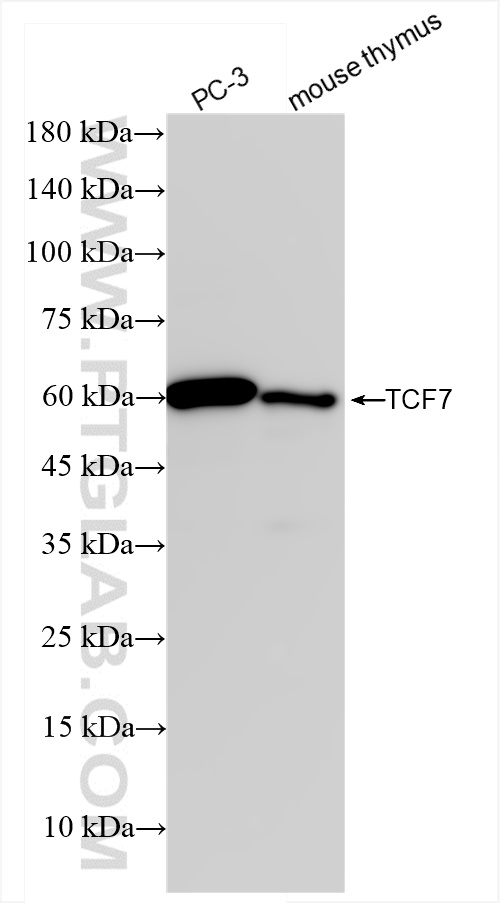验证数据展示
经过测试的应用
| Positive WB detected in | PC-3 cells |
推荐稀释比
| 应用 | 推荐稀释比 |
|---|---|
| Western Blot (WB) | WB : 1:5000-1:50000 |
| It is recommended that this reagent should be titrated in each testing system to obtain optimal results. | |
| Sample-dependent, Check data in validation data gallery. | |
产品信息
84089-4-RR targets TCF1/TCF7 in WB, ELISA applications and shows reactivity with human, mouse samples.
| 经测试应用 | WB, ELISA Application Description |
| 经测试反应性 | human, mouse |
| 免疫原 | TCF1/TCF7 fusion protein Ag5792 种属同源性预测 |
| 宿主/亚型 | Rabbit / IgG |
| 抗体类别 | Recombinant |
| 产品类型 | Antibody |
| 全称 | transcription factor 7 (T-cell specific, HMG-box) |
| 别名 | TCF7, TCF-1, TCF1, TCF 7, TCF 1 |
| 计算分子量 | 42 kDa |
| 观测分子量 | 58 kDa |
| GenBank蛋白编号 | BC048769 |
| 基因名称 | TCF1/TCF7 |
| Gene ID (NCBI) | 6932 |
| ENSEMBL Gene ID | ENSG00000081059 |
| RRID | AB_3671655 |
| 偶联类型 | Unconjugated |
| 形式 | Liquid |
| 纯化方式 | Protein A purfication |
| UNIPROT ID | P36402 |
| 储存缓冲液 | PBS with 0.02% sodium azide and 50% glycerol , pH 7.3 |
| 储存条件 | Store at -20°C. Stable for one year after shipment. Aliquoting is unnecessary for -20oC storage. |
背景介绍
TCF7, also known as TCF1, belongs to the TCF/LEF family. TCF7 is part of the Wnt signaling pathway and plays an important role in the differentiation and self-renewal of memory T cells. It has been found that TCF7 is necessary to revive T cells in response to PD-1 blockade against viral infection or cancer. TCF7 is mainly expressed in T-cells and is also detected in proliferating intestinal epithelial cells and in the basal epithelial cells of mammary gland epithelium. TCF7 has 16 isoforms with the molecular mass of 28-54 kDa (PMID: 34044317).
实验方案
| Product Specific Protocols | |
|---|---|
| WB protocol for TCF1/TCF7 antibody 84089-4-RR | Download protocol |
| Standard Protocols | |
|---|---|
| Click here to view our Standard Protocols |
